Family : Nepenthaceae

Text © Prof. Pietro Pavone

English translation by Mario Beltramini
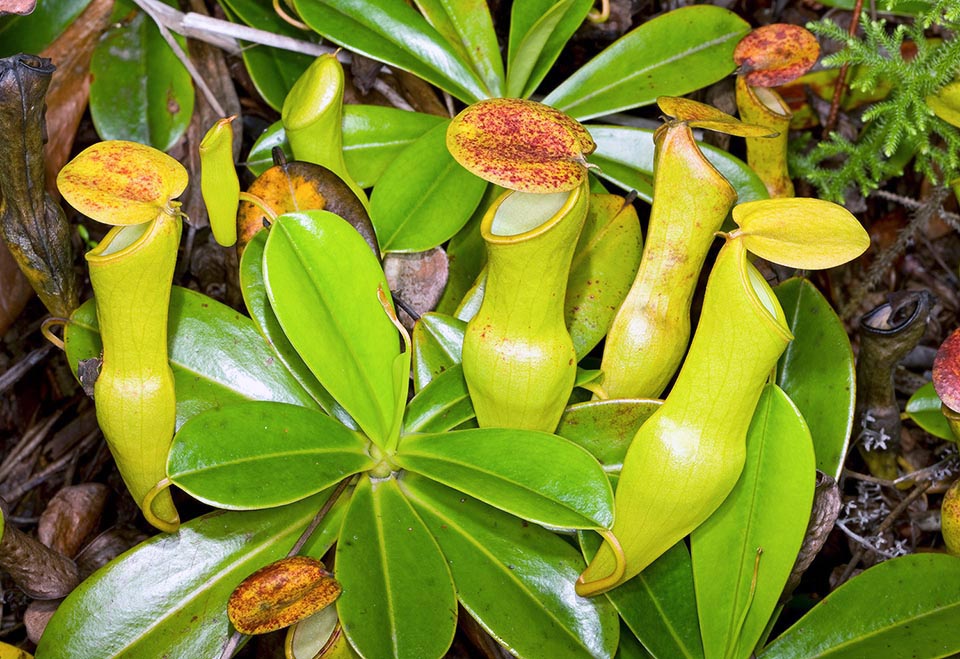
Nepenthes pervillei is the only carnivorous Seychelles plant, endemic to Mahé and Silhouette islands between 400 and 75O m of altitude © Giuseppe Mazza
Nepenthes pervillei Blume is a carnivorous plant of the family Nepenthaceae, the only one found in the Seychelles where it is endemic to the islands of Mahé and Silhouette. It grows in the low shrubland, at times under direct sunlight, on the granitic summits that rise abruptly from the underlying plain (inselberg) at an altitude varying from 350 to 750 m above the sea level.
In Mahé they call it “Lalyann potao” and was described for the first time in 1852 as Nepenthes pervillei, however, in 1921 it was transferred to the monotypic genus Anurosperma as Anurosperma pervillei (Blume) Hallier f. due to some of its characteristics such as the morphology of its seeds that differed from the other Nepenthes.
Later studies have taken it back into the genus Nepenthes as considered as a “primitive” species within this genus. Also the molecular phylogenetics has confirmed this interpretation even considering it as a basal group inside the genus, that is a twin lineage (sister group) of all other species of Nepenthes.
The morphologic characteristics of Nepenthes pervillei are quite particular: creeping and climbing posture, panicle inflorescence (ramified and consequently primitive), flower with tepals of the female flowers merged and seeds having no tails.
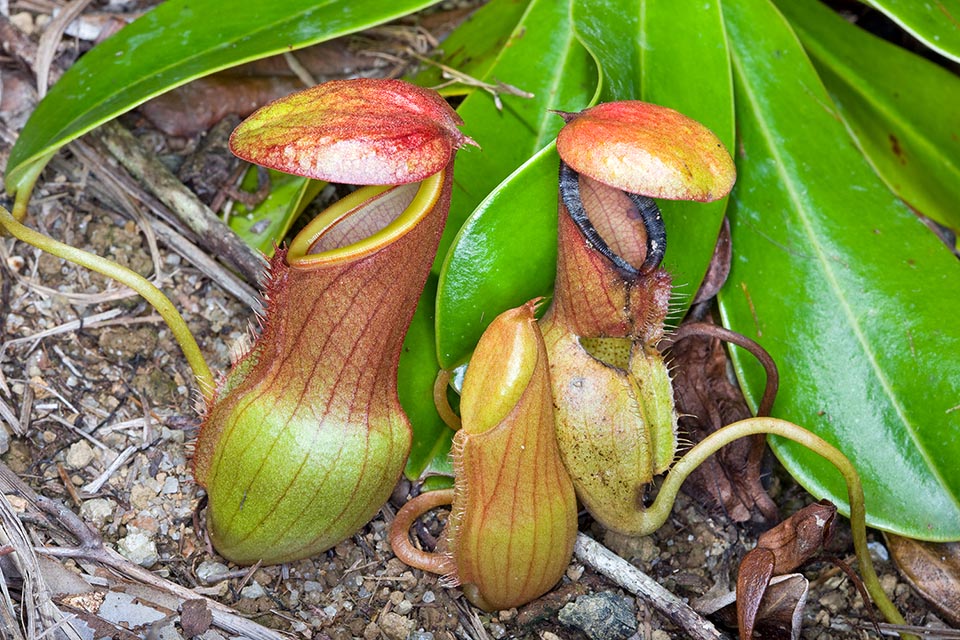
The lower ascidia may reach even 12 cm of length and 4 cm of breadth. They have an ovate or spheroid shape in the lowest half to then get narrower above to become with cylindrical or infundibular structure towards the opening. In the fore portion, they have up to 8 mm broad wings with up to 4 mm long filaments © Giuseppe Mazza
Because of these characteristics it appears to be a relict species living on soils formed by rocks geologically and geomorphologically old in contrast with the high diversity typical to the genus Nepenthes. Moreover, despite being located between Madagascar and Asia, the Malagasy species and the Asian ones seem to be genetically closer together than to Nepenthes pervillei. Therefore, the two Madagascar species, Nepenthes masoalensis Schmid-Höllinger and Nepenthes madagascariensis Poir. have been considered as sister group of the clade that includes also the Asian species. Remains confirmed the hypothesis that the present species of Nepenthes are of African origin and have reached Asia when the Indian plate has detached from Madagascar in late Cretaceous.
The name Nepenthes comes from the old Greek “νηπενθής”, (nipenthos), formed by the negative prefix νη, nê, “non”, and the name “πένθος”, (penthos) “sadness, pain”.
This term was used by Homer, in the fourth book of its Odyssey, to indicate the drink “Nepenthes pharmakon” that Helen, covertly, has poured into the wine that Telemachus, son of Ulysses, and Menelaus, prince of Mycenae and her husband, were drinking to soothe, thanks to its effect of rubbing off the memories, the pain and the nostalgy caused by the distance of their native country.
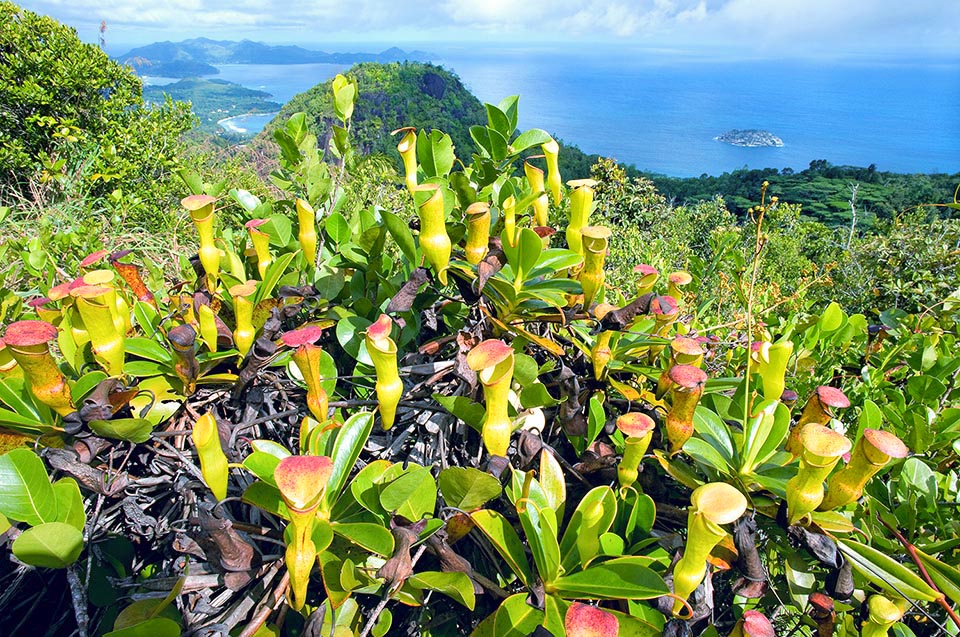
The leaves of young plants are arranged in compact rosettes, each with one tendril. The mature plants climb the surrounding vegetation by means of up to 8 m long stems that carry leaves with spiral tendrils for fixing to the branches of the supporting plants. On the stem nodes then get form compact aerial rosettes with the upper ascidia © Giuseppe Mazza
Linnaeus in his opus “Species Plantarum, 1753” called Nepenthes distillatoria L. a plant coming from Sri Lanka imagining that the sight of this wonder of Nature, after such a long voyage, would make people forget the tiredness of finding it.
The specific epithet pervillei stands in honour to its discoverer, the French naturalist Auguste Perville who collected this plant in 1841, with a detailed description, while engaged in an expedition in Madagascar and to the Seychelles, in order to increase the herbarium of Paris Natural History Museum.
Nepenthes pervillei is a terrestrial plant with creeping stems that elongate for climbing on other plants. Its roots extend in depth, along the fissures of the rocks, allowing the plant to tolerate drought periods. The young plants are arranged in compact rosettes with many leaves, each one with a tendril. The mature plants climb the surrounding vegetation by means of up to 8 m long stems carrying leaves with spiral tendrils for fixing on the branches of the supporting plants. The leaves of the stem rarely bear ascidia whilst at the nodes get form compact aerial rosettes whose sessile leaves form ascidia attached to the extremity of short and robust tendrils, bent and not twisted.
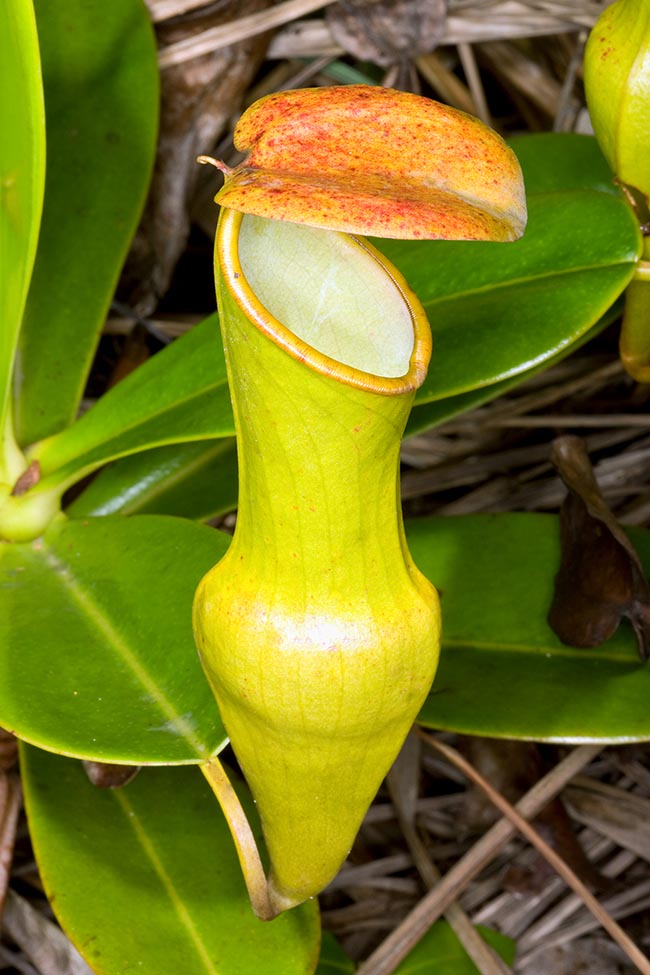
The upper ascidia, up to 16 cm long and 4,5 cm broad, are supported by short rigid tendrils. The opening is always in direction opposite to the stem. The well with the liquid for the prey has 400-600 digestive glands per cm² © G. Mazza
Some rosettes may form other stems that will elongate on the top of the nearby plants or on the ground forming a dense carpet of ascidia changing colour little by little while they mature.
The leaves have elliptic or oblong (29 cm x 6 cm) lamina with rounded or obtuse apex and with the base wrapping the stem. The foliar laminae, while developing, open like a book, whilst in all other species of Nepenthes they open laterally being curled on the central vein. Their surface is quite glossy, dark green. The petiole can be yellow, green, or, sometimes, bright red. Usually, all parts of the plant have no hairs, (glabrous), but the ascidia in the process of formation and parts of the inflorescence may be covered by simple hairs.
The lower ascidia may reach 12 cm of length and 4 cm of breadth. They have an ovate or spheroidal shape in the lower half to shrink above to become a cylindrical or infundibular structure towards the opening. The ascidia, in the fore portion, have up to 8 mm broad wings with up to 4 mm long filaments that approach downwards.
The peristome is glossy, up to 6 mm broad, and is covered by thin veins up to 1 mm tall, spaced about O,5 mm each from the other. The cover is sub-orbicular, flat, up to 5,5 cm of diametre, with many (30-100) nectariferous glands on the lower surface. Its presence, shaped like an umbrella, is there to prevent the rain from diluting the liquid contained in the ascidium. The spur is up to 7 mm long and usually is forked. The outer part of the ascidium and the cover are of orange, reddish or violet colour. The interior of the scidium is of pale pink, almost white, colour, whilst the peristome can be yellow, green, orange or red.
The upper ascidia, up to 16 cm long and 4,5 cm broad, are supported by rigid S-shaped tendrils, often of only a few centimetres. The opening of the ascidium is always in the opposite direction to the stem. The lower part is infundibular, swollen in a variable way, with the inner surface covered by digestive glands that have a density of 400-600 per cm².
The upper portion has less glands and gets narrower up to become cylindrical towards the opening. The peristome is up to 3 mm broad and is covered by thin veis up to 1 mm tall. The wings are reduced to narrow crests going down along the fore part of the ascidium, or are not visible. The lower surface of the cover is covered by glands that produce nectar. The colour of the upper ascidia is usually pure yellow or yellowish green suffused with orange, but with ageing the ascidia get darker and become reddish or violaceous. Usually the cover has the same colour as the ascidium, but its lower surface can be bright red.
The ascidia of Nepenthes pervillei usually catch insects, usually ants, host bacteria and the mite Creutzeria seychellensis, as commensal, and also larvae of the small endemic mosquito Uranotaenia nepenthes that utilizes them for reproducing.
Nepenthes pervillei is, like all species of Nepenthes, a dioecious species which means that it has separate male and female plants.
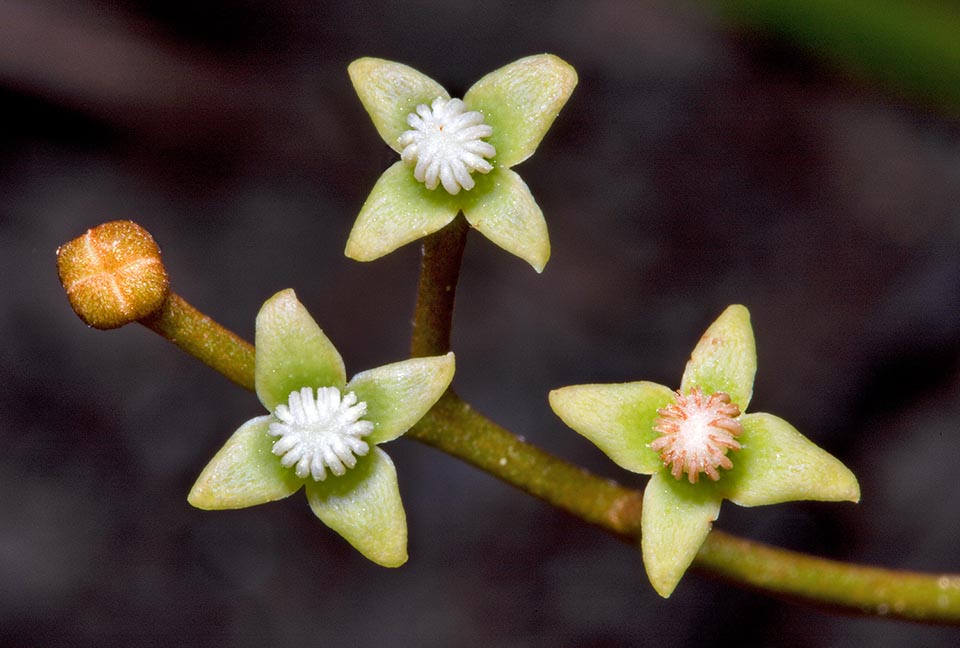
The flowers are merged in panicle inflorescences up to 40 cm long. The male flowers have commonly 4 tepals and stamens with the filaments fused in a short column © Giuseppe Mazza
The flowers are merged in panicle inflorescences up to 40 cm long, with branches having up to 12 male flowers, often unidirectional, and up to 5 female ones. The tepals, sometimes 3 instead of 4, have an ovate shape, with acute apex, rich in nectariferous glands. The male flowers commonly have 4 tepals and stamens with the filaments merged in a short column (androphore) that supports the anther. The female flowers with tepals reduced and fused at the base, have 3-4 stigmas and an ovary with 3-4 loculi.
The fruits are about 8-14 mm long and are atypical if compared with the other species of Nepenthes because they are obconic, that is not attenuated at the ends, and open with three valves and not four. The seeds are typically short, of black colour, ovoid or truncated, without wings, 2-4 mm long, that have difficulties in being diffused by the wind. This particular shape of the seed is an adaptation to the habitat inselberg as it reduces the probability that the seed may be sent away too far from the mother plant and therefore lost in the sea.
The IUCN Red List classifies Nepenthes pervillei as a species with the least risk (Least Concern).
Nepenthes pervillei is a “lowland” species and for its cultivation requires a terrarium that will have to recreate the conditions of zones of tropical plain with humidity at times very high over the 70% and constant day and night temperatures, usually 25-28°C.
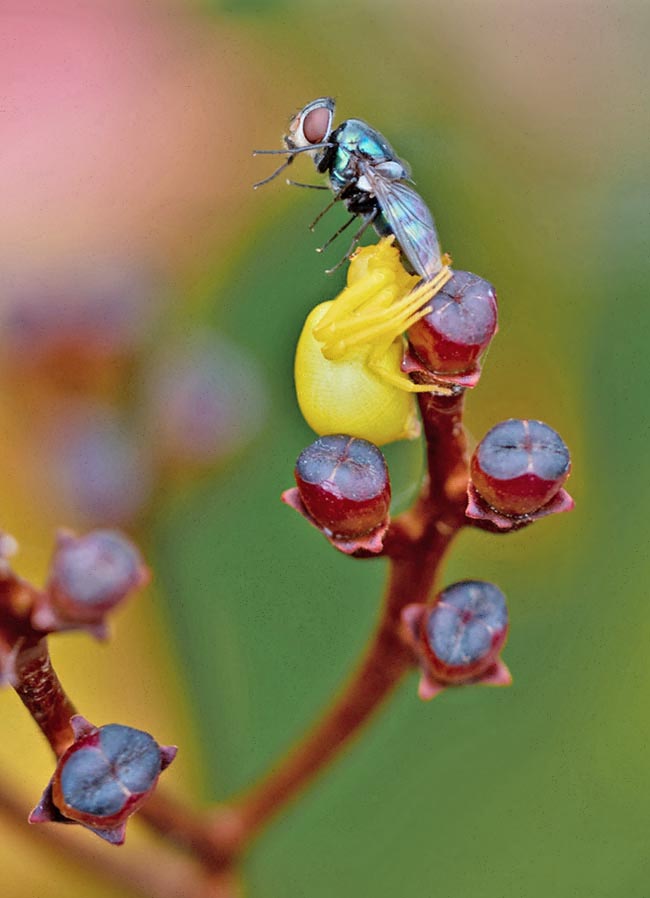
Nepenthes pervillei female inflorescence close-up with growing fruits. A commensal crab spider, taking advantage from the capacity of the plant to attract the insects, has caught a fly with its poisonous bite © Michael Zehnder
As the stems stretch for several metres, with elegant aerial rosettes, it is good practice to grow the plant in a warmed-up greenhouse.
However, do exist few literature data concerning the cultivation of this species that surely is a carnivore reserved for growers having a good experience.
For those who want to try, we suggest a well draining soil formed by a mix of granite (40%), lava rock (10%), “seramis” granulate (5%), Exclay expanded clay (5%), quartz sand (10%), perlite (10%) and New Zealand long fibre sphagnum (20%).
This plant reproduces by seeds and by cutting.
Normally the plants are sold in 10 cm pots, with moss of long fibre sphagnum and perlite. If you have chosen to cultivate it in a pot the size must not be excessive provided the sod enters and some room for the growth remains in such a way that the leaves may stretch even over the edge of the vase. The young plants are to be protected against the strong insolation whilst the adult ones love very luminous environments, or even sunny, and this is possible when the leaves get coriaceous and somewhat succulent in order to prevent the plant from dehydrating.
For the nitrogen feeding in the ascidia may be put in insects until when the plant will not be big enough. In such a case it will be possible to insert small balls of the fertilizer Osmocote that releases the nutrients in very long times, about 6 months.
Nepenthes pervillei has been depicted for the first time by the Seychelles Government in the stamp issued on December 29th 1970 of the facial value of 20 cents. On April 10th 1978 another stamp of the value of 15 rupees was issued. The second edition of this stamp was published in 1980 and two more editions have been done during the following years.
Another stamp of the facial value of 7 rupees was published on November 17th, 1983 to commemorate the centenary of the visit to the Seychelles of the English illustrator and naturalist Marianne North (1830-1890). Also Madagascar issued in August 6th, 1973 a stamp (38,5 mm x 38,5 mm) of the value of 25 F / 40 F, depicting this species with a design showing the transverse section of the ascidium in a very stylized way.
In 2012 and in 2016 have been issued two sets of coins, respectively of the value of 10 and 5 rupees, depicting the ascidium and part of the leaves and in the back the emblem dated May 27th 1976, day when the Seychelles achieved the independence, becoming and independent republic within the Commonwealth.
Synonyms: Anurosperma pervillei (Blume) Hallier f. (1921); Nepenthes wardii E.P.Wright (1869)
→ Per apprezzare la biodiversità all’interno della famiglia delle NEPENTHACEAE cliccare qui.
